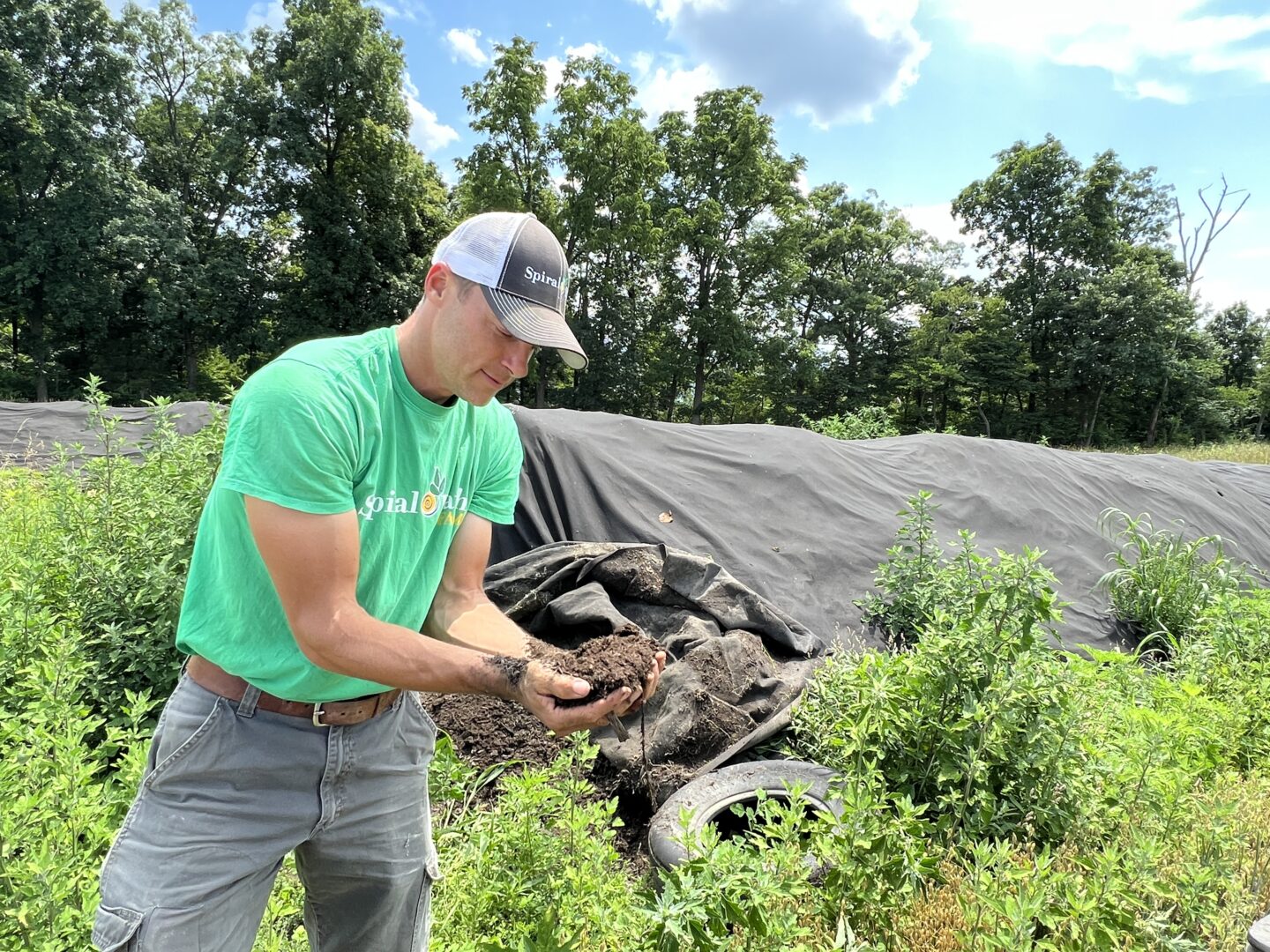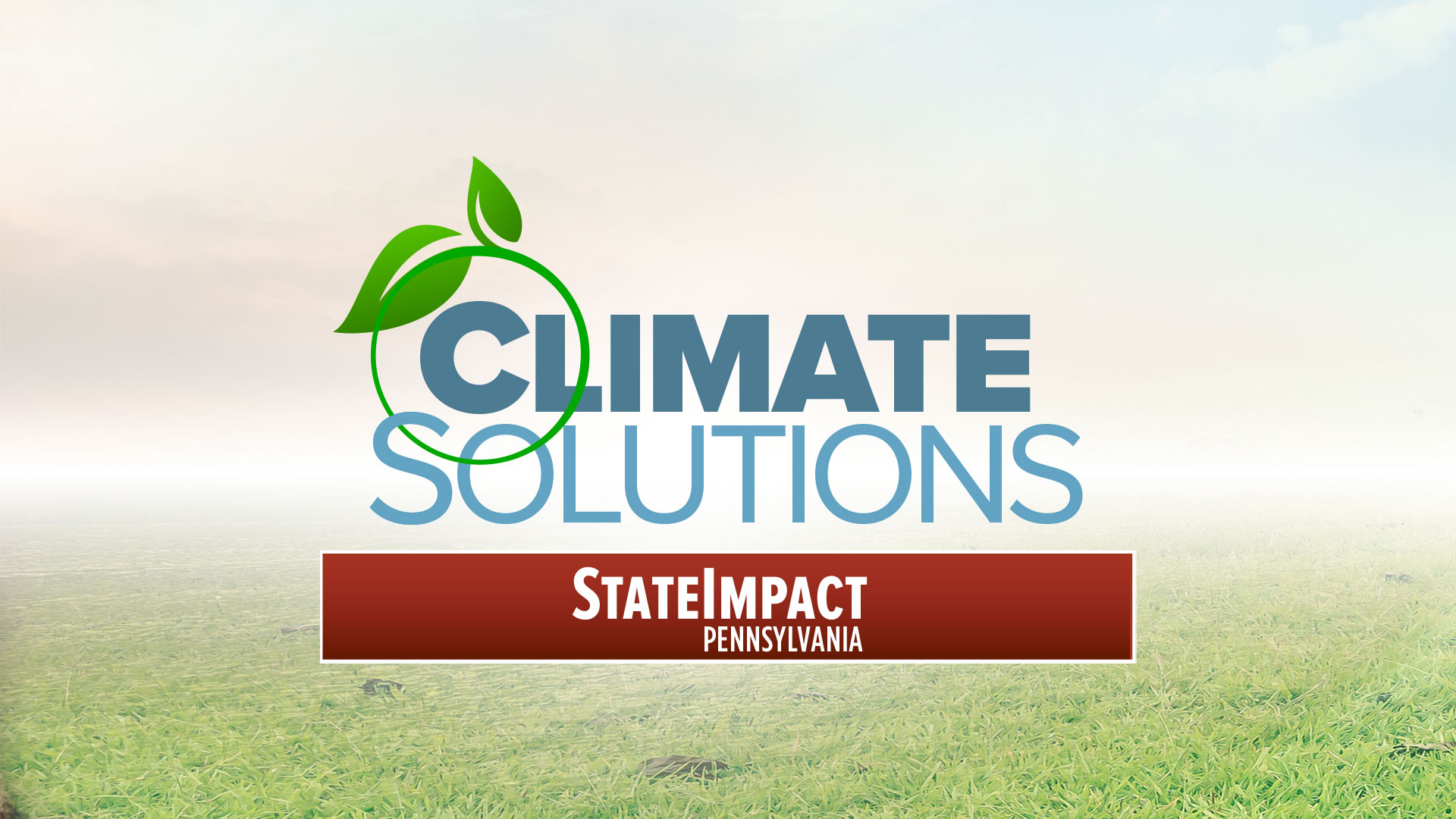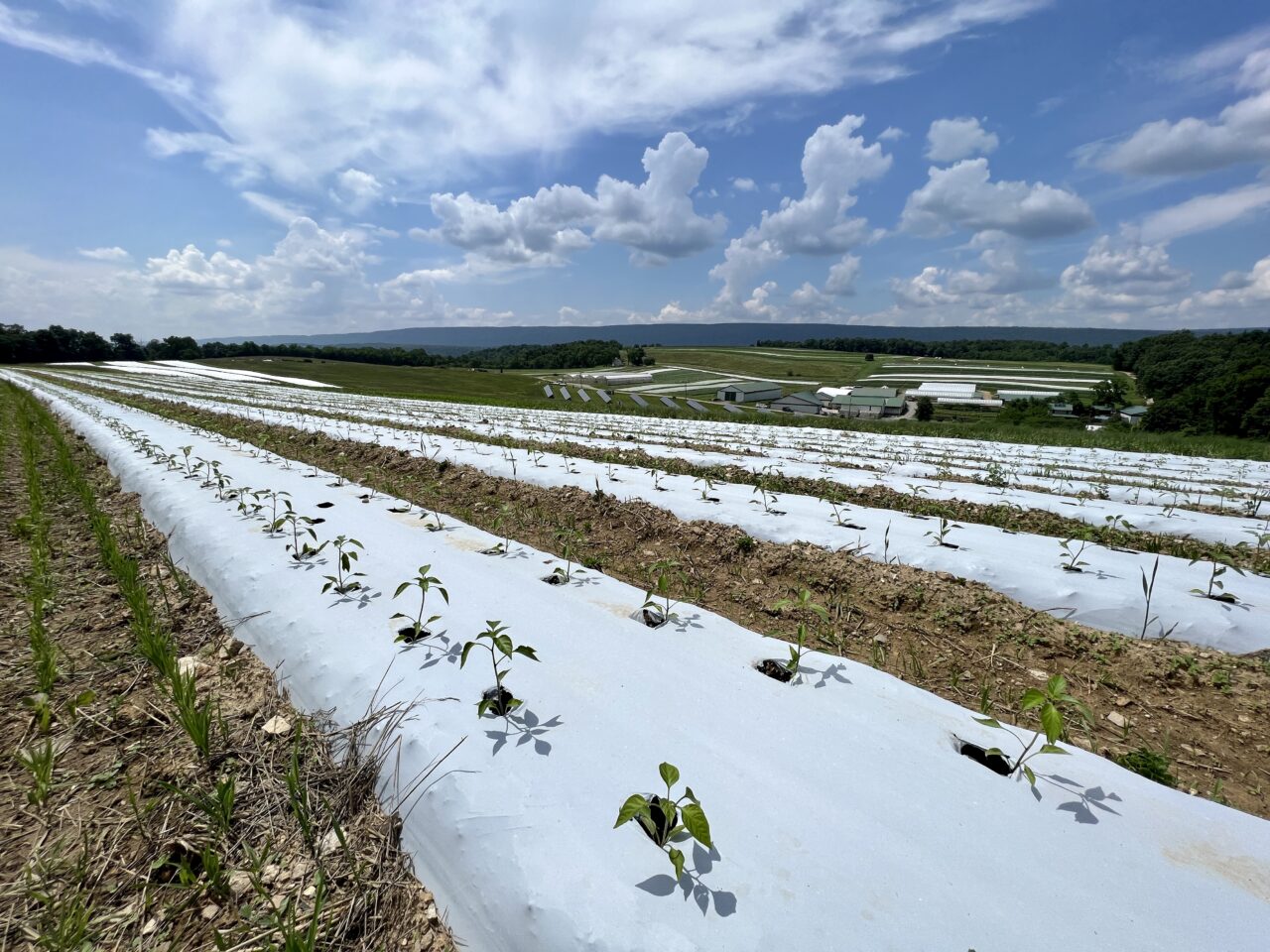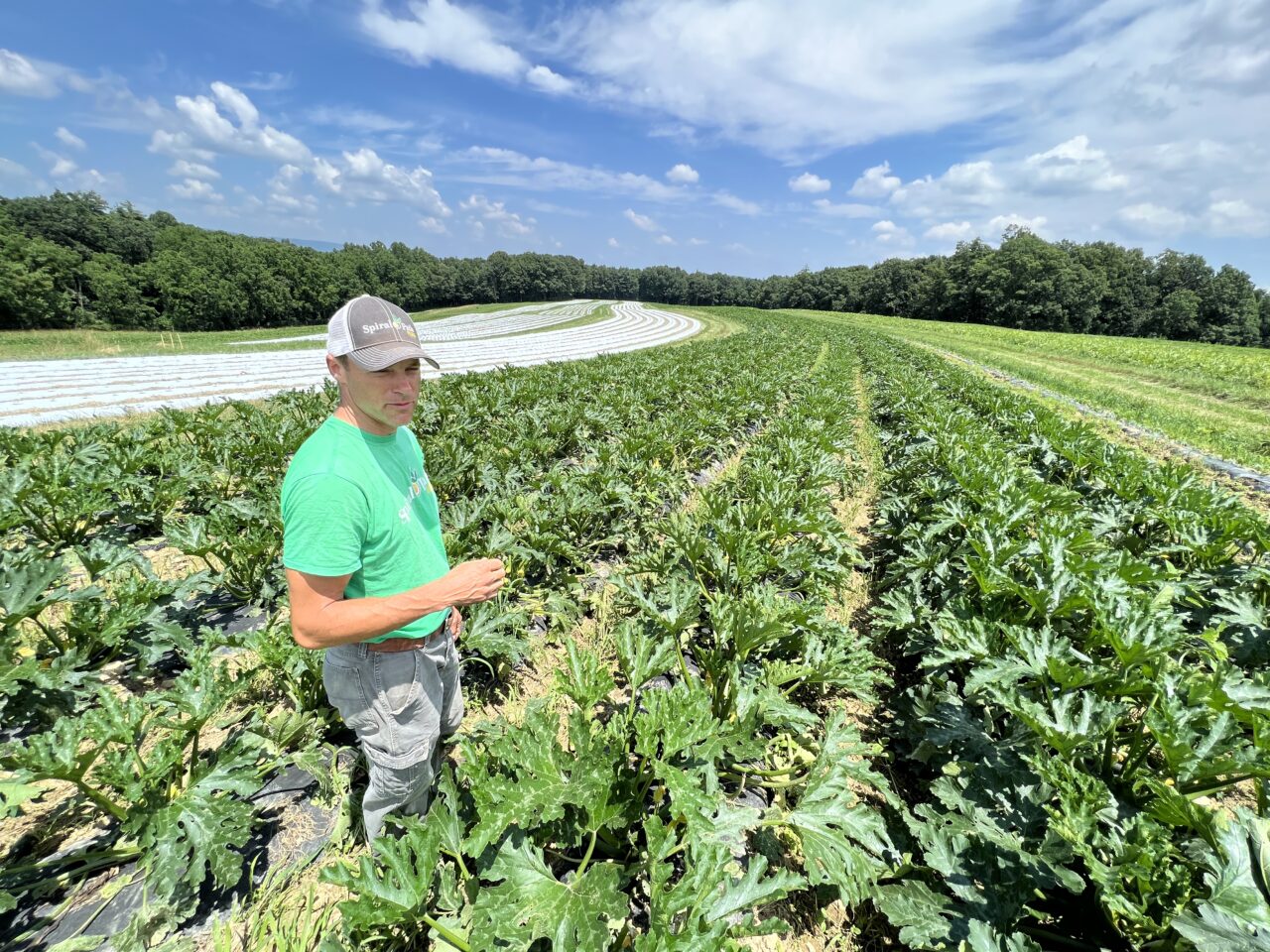
Will Brownback, owner of Spiral Path Farm, unwraps compost curing that is to be spread on his fields in the spring of 2024. Adding organic matter improves soil health and helps to mitigate climate change.
Karen Hendricks / for Climate Solutions


Will Brownback, owner of Spiral Path Farm, unwraps compost curing that is to be spread on his fields in the spring of 2024. Adding organic matter improves soil health and helps to mitigate climate change.
Karen Hendricks / for Climate Solutions

Karen Hendricks / for Climate Solutions
Will Brownback, owner of Spiral Path Farm, unwraps compost curing that is to be spread on his fields in the spring of 2024. Adding organic matter improves soil health and helps to mitigate climate change.
 This story was produced as part of Climate Solutions, a collaboration focused on community engagement and solutions-based reporting to help Central Pennsylvania move toward climate literacy, resilience and adaptation. StateImpact Pennsylvania convened the collaboration; WITF is a Climate Solutions partner. Other Climate Solutions partners are Franklin & Marshall Center for Public Opinion, La Voz Latina, Sankofa African American Theatre Company, Shippensburg University, Q’Hubo News, and the York Daily Record.
This story was produced as part of Climate Solutions, a collaboration focused on community engagement and solutions-based reporting to help Central Pennsylvania move toward climate literacy, resilience and adaptation. StateImpact Pennsylvania convened the collaboration; WITF is a Climate Solutions partner. Other Climate Solutions partners are Franklin & Marshall Center for Public Opinion, La Voz Latina, Sankofa African American Theatre Company, Shippensburg University, Q’Hubo News, and the York Daily Record.
Correction: Pasa’s original name was incorrect in the original version of this story.
Will Brownback stood in field C10, surrounded by tomato plants. As far as the eye could see, the leafy green plants rippled lightly in the wind as the summer sun beat down on them. The leaves shielded the growing, green fruit underneath.
Thousands of customers are awaiting those tomatoes. It’s a list that includes Wegmans, two farmers’ markets in Washington, D.C. and 1,700 Central PA households — members of Spiral Path Farm’s Community Supported Agriculture (CSA) program.
But the success of this crop — and about 50 other vegetables grown on the 300-acre organic vegetable farm — largely depend on two things: the weather, and climate-smart resiliency tactics.
“We just experienced the driest May and beginning of June that I’ve ever known — that my father has ever known — it was scary dry,” said Brownback, second-generation farmer/owner of Spiral Path Farm, in Loysville, Perry County.
Tomatoes may be the literal fruit of his labor, which is focused on climate-friendly sustainability happening under the surface, directly in the soil. Brownback believes his soil-centric focus is the reason his tomatoes are thriving — despite that dry spell — and will ultimately be tasty.
“I attribute the flavor to all of our soil practices,” Brownback said. “I’m going to get science-y on you — but when we have healthy soil, we’re allowing the plants to make these plant secondary metabolites — some people call them phytonutrients. Your tongue is able to pick those out.”
Brownback is one of about 200 “citizen scientist” farmers participating in the Soil Health Benchmark study organized by Harrisburg-based Pasa Sustainable Agriculture. The study, launched in 2016 with Brownback as one of the first participants, is helping farmers learn how sustainable agricultural practices can impact and improve their farms’ soil — not only to make tomatoes tastier, but to help them adapt to and even mitigate climate change.
As Pennsylvania experiences weather extremes, including warmer and wetter weather attributed to climate change, perhaps no one is more attuned to those trends than farmers, who called for resiliency tactics and sparked Pasa’s initial launch of the Soil Health Benchmark Study nearly a decade ago.
Farmers who test soil and keep records have data as the climate changes, said Hannah Smith-Brubaker, Pasa’s executive director.
The USDA’s 36 identified climate-smart practices are divided into several categories, classifying them according to climate change mitigation impacts:
Soil Health, which reduces emissions and increases the soil’s carbon sequestration.
Nitrogen Management, aimed at reducing nitrous oxide, a greenhouse gas.
Livestock Partnership, which reduces manure’s methane emissions.
Grazing and Pasture, with a goal of reducing emissions and building soil’s carbon sequestration.
Agroforestry, Forestry and Upland Wildlife Habitat, credited with sequestering carbon in trees, plants and soil.
Restoration of Disturbed Lands, with a goal of improving previously mined or degraded land and thereby increasing carbon sequestration in the soil and perennial trees and plants.
Energy, Combustion and Electricity Efficiency, which reduces emissions and increases energy efficiency on farms.
Wetlands Restoration, which returns degraded wetlands and its functions.
Rice Practices, aimed at reducing methane emissions from rice fields.
“It gives them a baseline and a place to start, so those farmers who have been in the study year-after-year are starting to see, ‘In heavy rain years there are dramatic changes in my soil,’ and then knowing what to do as a result of that — which is the report they get back advising them,” she said.
Most of the participants, like Brownback, are in Pennsylvania. But the study — already the largest of its kind in the nation — is poised to grow beyond the Keystone State.
Pasa, a nonprofit, was awarded a $55 million USDA Climate Smart grant to help Mid-Atlantic/East Coast farmers across a 15-state footprint adopt sustainable farming practices that reduce or sequester carbon emissions, or prepare to be climate resilient, by expanding its Soil Health Benchmark Study, over the next five years. It’s part of the Biden administration’s $3 billion USDA Climate Smart Commodities grant program, which sets the goal of sequestering — through climate-smart ag practices — more than 60 million metric tons of carbon dioxide, an amount equivalent to that produced by 10 million gas-powered vehicles annually. Carbon is one of the leading greenhouse gases responsible for climate change.
“We know a lot of farmers already have climate-smart practices on the ground, but just need financial support and technical support to expand those practices,” said Smith-Brubaker.
Pasa, originally founded as the Pennsylvania Association for Sustainable Agriculture 30 years ago, guided farmers such as Brownback’s father through the process of being certified organic. Soil health and climate-smart practices are the latest evolution of Pasa’s purpose.
The Soil Health Benchmark study helps farmers measure and monitor their soil in three areas: physical attributes such as soil texture, biological components such as organic matter and respiration and chemical properties like nutrients.

Karen Hendricks / for Climate Solutions
A field of peppers at Spiral Path Farm, which is part of a wide-ranging soil study of what climate-friendly farming practices could help improve the health of soil, which can sequester carbon dioxide and be a potential solution to challenges posed by climate change.
All three, together, paint a holistic picture of each farm’s current soil health and establish benchmarks, including human-induced climate change impacts. U.S. soils have lost between 30 and 60 percent of their original organic matter, and it’s being lost faster than it’s being recovered, said Pasa’s 2021 report on soil health.
Farmers in the study collect soil samples from the same three randomly-selected fields annually. For Brownback, at Spiral Path Farm, that would be fields N3, N5 and C10 where tomatoes are growing this year. Pasa sends those samples to New York’s Cornell Soil Health Laboratory for analysis, accompanied by detailed records — like an annual farm diary — of all the farming activity corresponding to those fields.
“What we learned is we have really good organic matter — a metric used to describe both the living and dead carbon-based molecules in soil,” Brownback said. “We know that it buffers a lot of problems, we know that builds a lot of resilience into the soil.”
Farmers are stewarding about 20% of Pennsylvania’s land and more than 55% of America’s soil. The USDA’s top two priorities in its Action Plan for Climate Adaptation and Resilience are building resilience through soil health and increasing climate-smart strategies.
Composting — increasing the soil’s organic matter — is one of 36 “climate-smart” techniques identified by the USDA.
“It’s not exactly photogenic … but it has a lot of positives,” Brownback said, pulling back black plastic covering a huge pile of maturing compost. It was created last fall — a mixture of both carbon and nitrogen sources, such as waste vegetables, chipped wood and cardboard. It’s like a recipe, Brownback explains. Compost piles are turned frequently to introduce another essential ingredient, oxygen. By the spring of 2024, it’ll be ready to spread onto the farm’s fields.
Increasing the soil’s organic matter, according to Pasa’s soil study, means that when it rains, especially during increased and prolonged rainfall associated with climate change, farmland with more organic matter could soak up more rainfall and potentially decrease runoff.
This summer, Brownback began experimenting with another climate-smart practice, cover crops, by planting oats in between rows of green and gold squash. He hopes it not only enriches the soil—but suppresses weeds and lessens erosion — which could both happen if the soil remained bare. The plants also capture carbon.

Karen Hendricks / for Climate Solutions
Will Brownback is growing oats in between squash and other crops in the hopes of improving soil health at Spiral Path Farm.
Spiral Path Farm’s soil health results also have room for improvement. Brownback said it has “really poor aggregate stability.”
With fungi acting as “glue,” aggregate stability describes how well the soil holds together, Brownback said. There’s one common agricultural practice that breaks up that naturally-occurring fungi: Tillage, or turning the soil.
“When you have a tillage-intensive farm such as an organic vegetable farm, you tend to have less fungi because the tillage breaks up the fungi,” Brownback said. “What that tells me is we should strive for ‘no-till,’ but we still have to make a living and provide healthy vegetables for as many people as possible.”
It’s a balancing act, he said. Pasa’s soil report notes that a no-till approach is not always necessary to achieve “optimal soil” — the study’s “most remarkable revelation [that] challenges a popular theory among farmers and other industry professionals.”
Christina Kostelecky, Pasa’s operations manager, addressed the lower carbon footprint associated with low or no-till.
“The fewer passes a tractor takes through the field, the less petrol being used and the less compaction to the soil,” she said. “Also, because you’re not turning over soil, you’re not releasing carbon.”
The 2021 soil study relies on data from 106 participating farmers, mostly in Pennsylvania. Participation has jumped since then, to 200 farmers. Sarah Bay Nawa, Pasa’s lead research coordinator, whose role includes outreach and recruitment, is preparing for those numbers to soar higher.
Ag products hailing from climate-smart farms — everything from eggs, cheese and beef, to lettuce, carrots and tomatoes — might be healthier for us. Pasa is studying whether that’s the case.
“It’s taking farms in our soil health survey, taking measurements of their plants and products, doing a comparative analysis of their nutrition, and already, there’s definitely a difference, particularly with protein levels in eggs and meat,” explained Hannah Smith-Brubaker, Pasa’ executive director.
“Anytime you are growing a product in a way that has been approached holistically and with the ecosystem in mind without synthetic chemicals, and in the case of animals where they’re eating what they’re naturally intended to eat, I’d say it’s a strong correlation — it’s going to be a healthier product.”
At Perry County’s Spiral Path Farm, farmer/owner Will Brownback will have planted seven rounds of grape tomatoes into his soil by the end of summer.
Brownback says his tomatoes are not only tasty, but also at the top, nutritionally. He believes Pasa’s Nutrient Density Study, tied to soil health, will bear that out.
“In my heart of hearts, I know growing crops on healthier soil produces healthier humans,” Brownback said. “Soil health goes to plant health goes to animal slash human health — it’s linear.”
Thanks to the USDA grant, Pasa is beginning to coordinate with 15 nonprofit partners from Maine to South Carolina, to enroll more farmers in the study.
The USDA grant not only underwrites Pasa’s staffing, outreach and training, but helps farmers with costs associated with implementing some of those 36 climate smart projects.
Three of those practices introduce trees into ag landscapes to sequester carbon and provide a ripple of additional benefits, Kostelecky said. Silvopasture adds trees to pastures where livestock can find shade, among other benefits. Agroforestry focuses on adding corridors of trees as buffers between waterways and fields. And alley cropping adds rows of trees in between crops.
In addition to those, Smith-Brubaker identifies pasture-based systems, also called dairy grazing, as one additional climate-smart practice she believes to be most impactful. It transitions farmers from raising grain to feed their livestock to creating pastures and allowing the animals to graze instead.
That can stop the “tilling and planting, tilling and planting” cycle that can deplete soil, she said, and introduce an “ecosystem cycle.”
Pasa has a dedicated staff member working with farmers interested in implementing pasture-based systems. Its soil report says those systems are the gold standard for soil health because, dairy grazing project manager Lucas Waybright said, of “grazing, manure, hoof impact—all those things are very prevalent in the natural world, and that’s how the world evolved for millions of years.”
Changing from conventional to pasture-based farming isn’t something that happens overnight, Waybright said. Still, Waybright is encouraged by the USDA Climate Smart grant.
“There wasn’t this level of funding from the government five years ago. To me, that shows that the needle is moving, heading in the right direction. Change is hard — no one is asking a farmer to completely change their farm overnight, and this is moving at their level,” Waybright said.
While it’s hard to define conventional farmers in one broad definition, Smith-Brubaker and Waybright agree they tend to rely more heavily on synthetic fertilizers and chemicals, driven by a focus on maximizing profits. And there are many shades of gray, between the black-and-white scenario of conventional vs sustainable farmers, many of whom use Pasa’s services, training or annual conferences.
“We like to think of sustainability as a spectrum. We have conventional farmers interested in soil health, those taking baby steps to sustainability all the way to regenerative ag and certified organic farmers,” said Smith-Brubaker, who estimates there are about 60,000 East Coast farmers she would label as “sustainable.”

Tomato plants grow on field C10, one of three Spiral Path Farm fields enrolled in the nonprofit Pasa Sustainable Agriculture’s Soil Health Survey.
Although Pasa, via the USDA grant award, is an industry leader, it’s touching only a fraction of farmers. The nonprofit has about 7,500 members, mostly in Pennsylvania. Compare that figure to the number of farms — 57,900 according to the state Department of Agriculture.
And time is of the essence, as Pasa introduces and increases climate-smart practices to Mid-Atlantic/East Coast farmers within that sustainability spectrum. Their work can feel like a race against climate change, since it can take years for farmers to transition to pasture-based systems or see improvements in soil health scores, following changes in farm practices.
Collectively, the expansion of Pasa’s soil health study across Pennsylvania into the Mid-Atlantic/East Coast regions could tell bigger stories about climate change’s effects on the earth and how climate smart ag practices are helping farmers adapt or even mitigate those changes. Farmers implementing climate-smart grant projects will be using the USDA’s web-based app COMET-Farm which helps farmers estimate their carbon footprint including greenhouse gas measurements and reductions.
But it’s not just farmers who benefit from soil health information — it’s also consumers and neighboring communities. Pasa’s soil report said agricultural runoff is a top source of water pollution and contamination in the U.S., and soil is “increasingly damaged by floods, droughts and severe storms.”
One farm’s climate-smart practices, such as Spiral Path Farm’s increased absorbent organic matter, can have a ripple effect through its community and region.
“If a farm can reduce flooding through their farming practices, that positively impacts everyone downstream,” Smith-Brubaker said.
That’s why Pasa is trying to put soil health on consumers’ radar screens, by providing colorful, shareable graphics to farmers enrolled in the study – “to help more folks understand these concepts and why they’re important,” Bay Nawa said.
Similarly, the USDA grant includes a marketing component, said Brubaker-Smith. Pasa is talking with other ag nonprofits across the country to define what ‘climate-smart’ ag products are and how they could be identified to consumers. It could be similar to the labeling and certification process for organic farmers. The hope is that people could choose ag products grown, raised or created by farmers who adhere to climate-smart practices.
“It’s like voting with their dollars,” said Waybright, “to purchase foods that are part of a system that creates more resiliency, not created through extractive means.”
In addition to marketing, Kostelecky said the grant includes measuring greenhouse gas and carbon benefits before and after climate-smart practices are used.
“By adding in more elements of climate-smart practices,” she said, “we’ll be able to see the before and after effects of climate-smart implementation. And we’ll be able to talk about which conservation practices have the biggest impacts.”
StateImpact Pennsylvania is a collaboration among WITF, WHYY, and the Allegheny Front. Reporters Reid Frazier, Rachel McDevitt and Susan Phillips cover the commonwealth’s energy economy. Read their reports on this site, and hear them on public radio stations across Pennsylvania.
(listed by story count)
StateImpact Pennsylvania is a collaboration among WITF, WHYY, and the Allegheny Front. Reporters Reid Frazier, Rachel McDevitt and Susan Phillips cover the commonwealth’s energy economy. Read their reports on this site, and hear them on public radio stations across Pennsylvania.
Climate Solutions, a collaboration of news organizations, educational institutions and a theater company, uses engagement, education and storytelling to help central Pennsylvanians toward climate change literacy, resilience and adaptation. Our work will amplify how people are finding solutions to the challenges presented by a warming world.